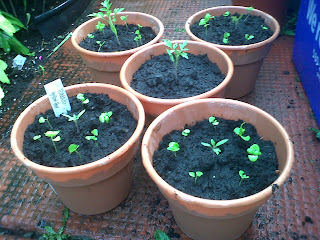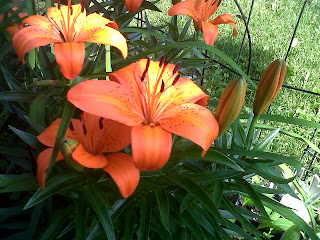 |
| Tomato with Basil-sweet! Companion plants - love affair! |
 |
| The chinese ginger, krachai, Boesenbergia rotunda) that I started in the flower vase last May 29, 2012. I potted it, and I am so happy with its first leaf coming out. |
 |
| Yellowish - very hairy caterpillar chewing my marigold. Looks like glow in the dark to my camera . LOL |
 |
| Pots and Pots of Tomato and sweet Basil. I put one pot without basil - will isolate her, and see the difference. Companion planting experiment. |
 |
| Germinated - Sweet Basil, must be like 50 of them in this pot. |
 |
| another close up of that glow in the dark caterpillar. |
I wake up - look at my watch and it was like 5:45 am. Light in my window and I was ready to have a conversation with myself - headed to the garden. I accomplished many things in the first two hours: picking up slugs from my lovely plants - they are all over the place - in my hosta, in my bittermelon, in my beans, in my Iris, in my coleus. They are --oh well - dumped in a jar of vinegar. I cannot picked up these slimy creatures, so tweezers come in handy. Snails were are their peak too. So as a very hairy caterpillar eating my marigold.
One pot of sweet basil was divided and put into grow pots. Tomato -----------oh how late? but I won't compost them, so lets see what happens in the fall. Will I get tomato if I planted them - small on June 29th? Wait and see...
Companion planting. Basil and tomato love each other. They are perfect companions and they grow well with in each others reach. I think at the end of the day Mr. Basil and Ms. Tomato have a good conversation, something like -- oh ms. tomato, nice flower!, and then she said - oh mr. basil - you are aromatic!
I experimented on this - one tomato, one basil in a pot, then 2 basil , one tomato up to 6 basil surrounding a tomato. They said - very good companions, I don't know how many the authors meant - so I am trying my own experiment. They are grown in compost mix - a weird looking bag I bought, it was labeled "peat and shrimp compost", this one did not become good enough for calamari i think.
two varieties of tomato - yellow pear and broad ripple. These seeds were heirloom and USDA organic - part of the batch i bought from Seed Savers Exchange.
anyways, time for work , and sort of enjoy my day, or at least try to. :)












































